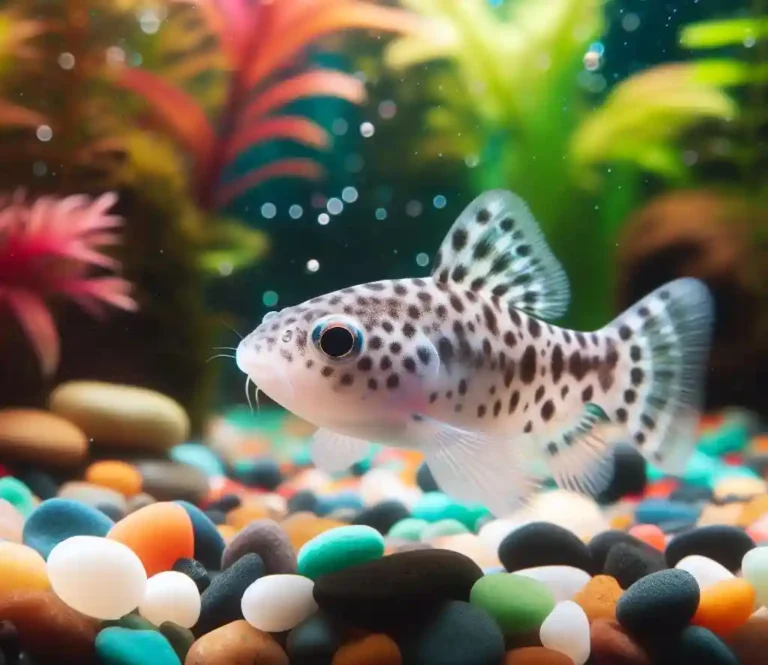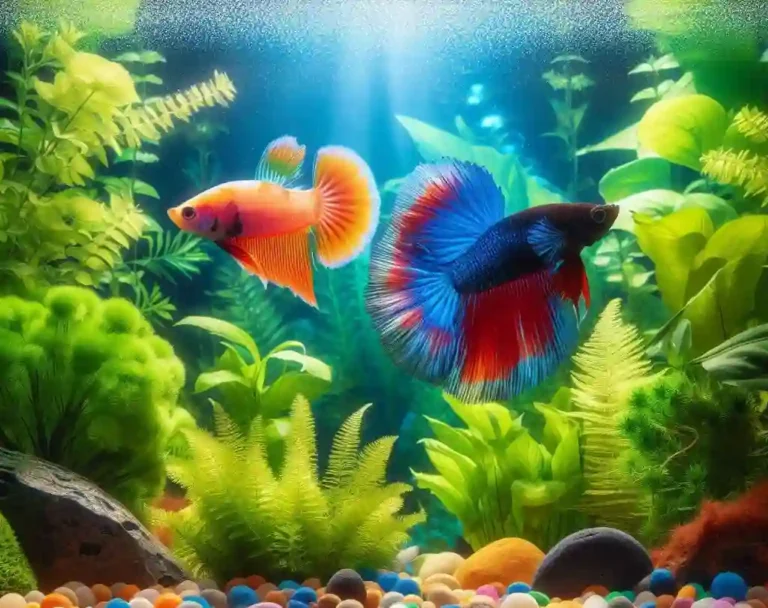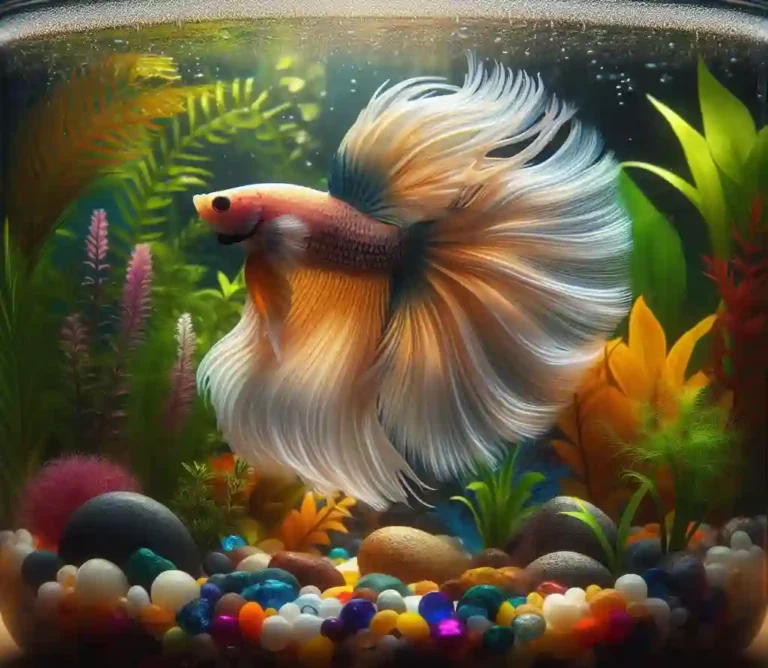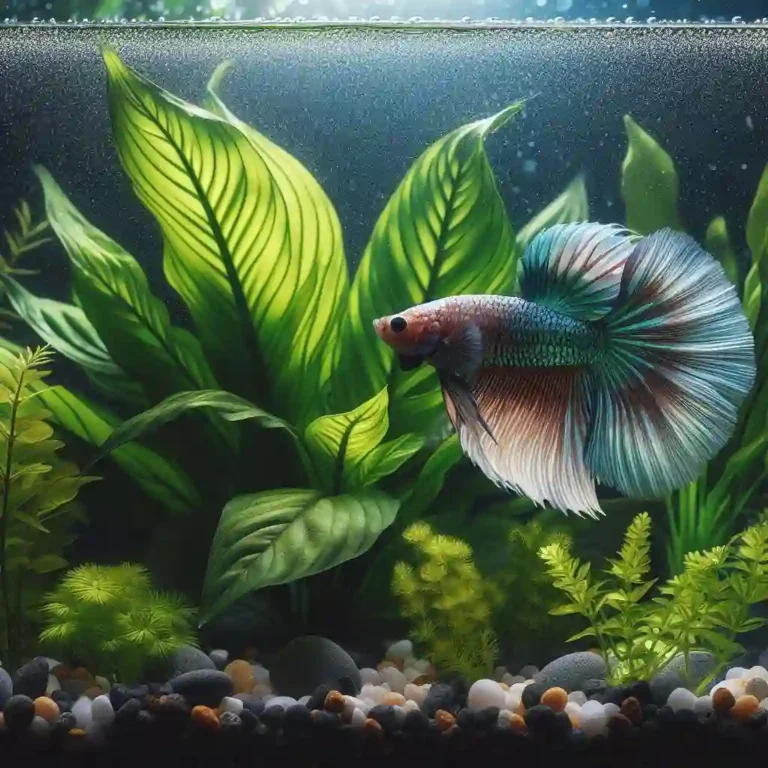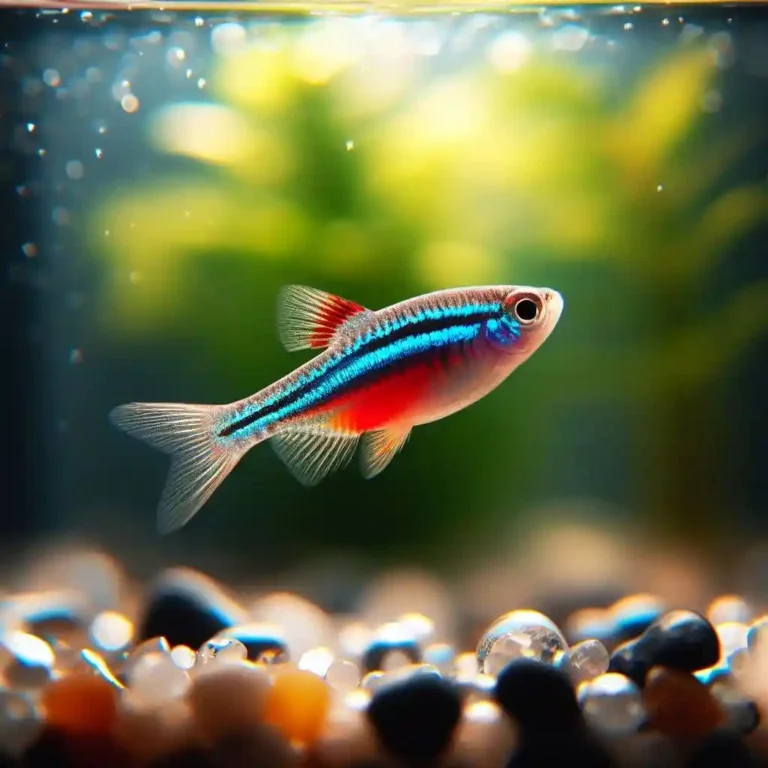Pregnant Swordtail Fish: What to Do and What to Expect
Pregnant Swordtail Fish: Are you thrilled to discover that your swordtail fish is pregnant? This exciting milestone marks the beginning of a new adventure in aquarium breeding.
As you embark on this journey, you’re likely filled with questions and concerns about what to expect and how to provide the best care for your expecting mother-to-be.
In this comprehensive guide, we’ll demystify the process of pregnant swordtail fish, covering everything from determining pregnancy to caring for the newborn fry.
Pregnant Swordtail Fish: A Quick Guide

Determining Pregnancy:
- Visual Inspection: Observe your female swordtail’s belly. A pregnant female will have a rounded, swollen abdomen, which will become more pronounced as the pregnancy advances.
- Behavioral Changes: Pregnant females may exhibit changes in behavior, such as:
- Reduced activity or lethargy
- Increased hiding or seeking solitude
- Changes in appetite or feeding behavior
Pregnancy Duration:
The gestation period for swordtail fish is approximately 24-30 days, depending on factors like water quality, nutrition, and genetics.
Care and Preparation:
- Separate the Female: Move the pregnant female to a separate breeding tank or a maternity tank to reduce stress and prevent fin nipping from other fish.
- Optimize Water Conditions: Maintain excellent water quality by performing regular water changes (25-50% every week) and monitoring water parameters (pH, ammonia, nitrite, and nitrate levels).
- Nutrition: Provide a balanced diet rich in protein and omega-3 fatty acids to support the developing fry.
- Prepare for Fry: Set up a separate fry-rearing tank with a heater, filter, and plenty of hiding places (e.g., plants, rocks) to help the newborns survive and thrive.
After Birth:
- Fry Care: Feed the newborns infusoria or a commercial fry food within 24 hours of birth. Monitor water quality and perform regular water changes to maintain a healthy environment.
- Monitor the Female: After giving birth, the female swordtail will be exhausted and vulnerable to disease. Monitor her health and provide a nutritious diet to aid in her recovery.
Tips and Reminders:
- Swordtail fish can store sperm for several months, so it’s possible for a female to become pregnant again without the presence of a male.
- Keep the breeding tank clean and well-maintained to prevent disease and stress.
- Be prepared for the possibility of multiple batches of fry, as swordtails can have multiple pregnancies in a short period.
Recognizing the Signs of Pregnancy in Swordtail Fish
Physical Changes
- Swollen Belly: One of the most obvious signs of pregnancy in swordtail fish is a swollen belly. As the eggs develop, the female’s abdomen will expand, becoming more rounded and larger than usual.
- Darkened Gravid Spot: The gravid spot, located near the anal fin, will darken in color as the eggs mature. This spot may turn a deeper shade of red or purple, indicating the presence of eggs.
- Weight Gain: Pregnant swordtail fish may appear heavier or more bloated than usual, especially around the midsection.
Behavioral Changes
- Increased Appetite: Pregnant swordtail fish may exhibit an increase in appetite, as they need more nutrients to support the developing eggs.
- Reduced Activity: As the pregnancy progresses, your swordtail fish may become less active, spending more time hiding or resting.
- Defensiveness: Pregnant swordtail fish may become more aggressive or defensive, especially when approached or threatened.
Other Signs
- Nesting Behavior: Some swordtail fish may exhibit nesting behavior, such as collecting plants or debris to create a nest for their eggs.
- Changes in Coloration: Some pregnant swordtail fish may display changes in coloration, such as a darker or more vibrant coloration, especially on the belly.
Optimizing Water Conditions for a Healthy Pregnancy

Water Temperature
- Ideal temperature range: 72°F – 82°F (22°C – 28°C)
- Avoid sudden temperature fluctuations, as they can cause stress and complications during pregnancy
Water pH
- Ideal pH range: 6.5 – 8.5
- Maintain a stable pH, as fluctuations can cause stress and disrupt the fish’s metabolism
Water Hardness
- Ideal water hardness: 5-10 dGH (90-180 ppm)
- Soft water can lead to osmoregulatory stress, while very hard water can cause dehydration
Water Quality
- Regularly test for ammonia, nitrite, and nitrate levels
- Perform regular water changes (10-20% every week) to maintain optimal water quality
- Monitor water clarity and make adjustments as needed to prevent cloudy or murky water
Water Flow and Oxygenation
- Maintain a moderate water flow to prevent stagnant water and promote oxygenation
- Ensure adequate oxygen levels, especially in heavily stocked tanks or during hot weather
Tips for Maintaining Optimal Water Conditions
- Regularly clean the gravel and decorations to prevent the buildup of debris and toxins
- Avoid overcrowding, as it can lead to water quality issues and stress
- Monitor water parameters regularly and make adjustments as needed
- Consider using a water conditioner to remove chlorine and chloramines from tap water
The Importance of Water Stability
Water stability is crucial during pregnancy, as sudden changes can cause stress and complications. By maintaining optimal water conditions, you can help reduce the risk of:
- Fetal abnormalities
- Premature birth
- Maternal stress and illness
- Fungal or bacterial infections
Diet and Nutrition for Pregnant Swordtail Fish

Key Nutrients for Pregnant Swordtail Fish
- Protein: High-quality protein sources, such as brine shrimp, bloodworms, or commercial pellets, are essential for fetal development and maternal health.
- Omega-3 Fatty Acids: These essential fatty acids, found in foods like spirulina or flaxseed, support heart health, brain function, and fetal development.
- Vitamins and Minerals: A balanced diet should include a range of vitamins (A, C, E, and K) and minerals (calcium, phosphorus, and iron) to support overall health and development.
- Fiber: A moderate amount of fiber, found in foods like algae or plant-based flakes, helps maintain a healthy digestive system.
Recommended Foods for Pregnant Swordtail Fish
- Live or Frozen Brine Shrimp: Rich in protein and omega-3 fatty acids, brine shrimp are an excellent food source for pregnant swordtail fish.
- High-Quality Commercial Pellets: Look for pellets specifically formulated for breeding or pregnant fish, as they often contain added nutrients and omega-3 fatty acids.
- Spirulina or Algae Flakes: These foods provide essential vitamins, minerals, and fiber for a balanced diet.
- Bloodworms or Earthworms: These protein-rich foods can be fed as an occasional treat or supplement to support fetal development.
Feeding Tips for Pregnant Swordtail Fish
- Feed Small, Frequent Meals: Divide daily rations into 2-3 meals to prevent overfeeding and maintain water quality.
- Monitor Food Intake: Adjust food amounts based on the fish’s appetite and activity level to prevent overfeeding or underfeeding.
- Provide a Variety of Foods: Rotate foods to ensure a balanced diet and prevent nutrient deficiencies.
- Avoid Overfeeding: Pregnant swordtail fish may have a reduced appetite; avoid overfeeding, as it can lead to water quality issues and stress.
Supplements for Pregnant Swordtail Fish
- Omega-3 Supplements: Add omega-3 fatty acid supplements to the fish’s food or water to support heart health and fetal development.
- Vitamin Supplements: Consider adding vitamin supplements, such as vitamin C or E, to support immune function and overall health.
Providing a Safe and Stress-Free Environment
Creating a Stress-Free Environment
- Provide Plenty of Hiding Places: Add plants, rocks, or decorations to create hiding places and reduce stress.
- Minimize Disturbances: Avoid sudden movements, loud noises, or excessive water changes, which can cause stress.
- Maintain Optimal Water Conditions: Regularly test and adjust water parameters to ensure optimal conditions for your pregnant swordtail fish.
- Reduce Aggression: Separate aggressive tankmates or provide plenty of space to reduce aggression and stress.
Designing a Safe Aquarium
- Choose a Suitable Aquarium Size: A minimum tank size of 10 gallons is recommended for pregnant swordtail fish.
- Select a Secure Lid: Prevent jumping and escape attempts with a secure lid or mesh top.
- Add Plants and Decorations: Incorporate plants, rocks, and decorations to create hiding places and visual barriers.
- Maintain Good Water Circulation: Ensure good water circulation to prevent stagnant areas and promote healthy water quality.
Tips for Reducing Stress
- Avoid Overcrowding: Maintain a reasonable bioload to prevent stress and water quality issues.
- Monitor Water Quality: Regularly test water parameters and make adjustments as needed to maintain optimal conditions.
- Provide a Quiet Environment: Place the aquarium in a quiet area to minimize external disturbances.
- Avoid Sudden Changes: Gradually introduce changes to the aquarium, such as new decorations or tankmates, to minimize stress.
The Importance of a Stress-Free Environment
A stress-free environment is crucial for pregnant swordtail fish, as stress can lead to:
- Fetal abnormalities
- Premature birth
- Maternal stress and illness
- Fungal or bacterial infections
The Stages of Swordtail Fish Pregnancy: What to Expect
Stage 1: Mating and Fertilization (Days 1-3)
- Males will display courtship behavior, such as fin nipping and dancing, to attract females.
- Females will release eggs, which will be fertilized by the male’s sperm.
- Fertilized eggs will begin to develop and divide.
Stage 2: Egg Development (Days 4-10)
- The fertilized eggs will continue to develop and grow, receiving nutrients from the yolk sac.
- The female’s belly will begin to swell as the eggs grow.
- The female may start to exhibit nesting behavior, such as collecting plants or debris.
Stage 3: Embryonic Development (Days 11-18)
- The embryos will continue to develop and grow, receiving nutrients from the yolk sac.
- The female’s belly will continue to swell, and she may start to show signs of fatigue.
- The embryos will start to move and develop their organs.
Stage 4: Fetal Development (Days 19-24)
- The fetuses will continue to grow and develop, receiving nutrients from the mother.
- The female’s belly will be at its largest, and she may start to show signs of discomfort.
- The fetuses will start to move and respond to stimuli.
Stage 5: Birth and Post-Birth Care (Days 24-30)
- The female will give birth to live young, which will be nourished by the yolk sac for several days.
- The female will need to be separated from the fry to prevent cannibalism.
- The fry will need to be fed a nutritious diet and provided with optimal water conditions.
Common Health Issues in Pregnant Swordtail Fish
1. Fungal Infections
- Caused by poor water quality, fungal infections can lead to fin rot, skin lesions, and respiratory distress.
- Treat with antifungal medications and improve water quality.
2. Bacterial Infections
- Caused by poor water quality, bacterial infections can lead to fin rot, skin lesions, and respiratory distress.
- Treat with antibacterial medications and improve water quality.
3. Parasitic Infections
- Caused by parasites such as ich, parasitic infections can lead to skin lesions, fin damage, and respiratory distress.
- Treat with antiparasitic medications and improve water quality.
4. Waterborne Diseases
- Caused by poor water quality, waterborne diseases such as velvet disease can lead to skin lesions, fin damage, and respiratory distress.
- Treat with antiparasitic medications and improve water quality.
5. Nutritional Deficiencies
- Caused by a poor diet, nutritional deficiencies can lead to weakened immune systems, poor growth, and reproductive issues.
- Provide a balanced diet rich in omega-3 fatty acids, protein, and vitamins.
6. Stress and Anxiety
- Caused by changes in water temperature, pH, or other environmental factors, stress and anxiety can lead to weakened immune systems and reproductive issues.
- Provide a stable environment, reduce stressors, and provide plenty of hiding places.
7. Pregnancy-Related Complications
- Caused by the physical demands of pregnancy, pregnancy-related complications such as egg binding, dropsy, and pregnancy toxemia can occur.
- Monitor the female’s health closely, and provide a nutritious diet and optimal water conditions.
Preventing Health Issues
- Provide optimal water conditions, including regular water changes and stable water parameters.
- Maintain a balanced and nutritious diet rich in omega-3 fatty acids, protein, and vitamins.
- Monitor the female’s health closely, and provide plenty of hiding places and stress reduction measures.
- Quarantine and treat any infected fish promptly to prevent the spread of disease.
Preparing for the Arrival of Fry: Setting Up a Breeding Tank
Choosing the Right Breeding Tank
- Select a tank that is specifically designed for breeding, with a secure lid to prevent jumping and a smooth, rounded interior to prevent injury.
- A minimum tank size of 10 gallons is recommended, with a secure filter and heater.
- Consider a tank with a built-in breeding basket or a separate breeding basket to separate the fry from the adults.
Setting Up the Breeding Tank
- Set up the breeding tank at least 2-3 weeks before the expected birth date to allow for cycling and stabilization.
- Use a high-quality aquarium filter, such as a sponge filter or a hang-on-back filter, to maintain optimal water quality.
- Add a heater to maintain a consistent water temperature between 76°F to 82°F (24°C to 28°C).
- Introduce beneficial bacteria to the tank by adding a bacterial supplement or by using a mature filter media from an established tank.
Water Quality and Cycling
- Perform regular water changes (10-20% every week) to maintain optimal water quality and prevent the buildup of toxins.
- Monitor water parameters, such as ammonia, nitrite, and nitrate levels, to ensure a healthy environment for the fry.
- Cycle the tank by adding a small amount of fish food or a commercial cycling product to stimulate the growth of beneficial bacteria.
Providing Hiding Places and Enrichment
- Add plants, rocks, or other decorations to provide hiding places and visual barriers for the fry.
- Incorporate enrichment items, such as a treasure chest or a sunken ship, to stimulate the fry’s natural behavior and provide mental stimulation.
Feeding the Fry
- Prepare a high-quality fry food, such as a commercial fry food or a homemade mixture of egg yolks and fish oil.
- Feed the fry 2-3 times a day, only as much as they can consume within a few minutes.
- Monitor the fry’s growth and adjust the feeding schedule accordingly.
Post-Birth Care: Caring for Your Swordtail Fish and Her Fry
Caring for the Mother
- Monitor the mother’s health closely, as she may be experiencing stress or fatigue after giving birth.
- Provide a nutritious diet, such as a high-quality commercial food or a homemade mixture of egg yolks and fish oil.
- Maintain optimal water quality by performing regular water changes (10-20% every week) and monitoring water parameters.
- Provide plenty of hiding places and visual barriers to reduce stress and anxiety.
Caring for the Fry
- Feed the fry 2-3 times a day, only as much as they can consume within a few minutes.
- Monitor the fry’s growth and adjust the feeding schedule accordingly.
- Provide a high-quality fry food, such as a commercial fry food or a homemade mixture of egg yolks and fish oil.
- Maintain optimal water quality by performing regular water changes (10-20% every week) and monitoring water parameters.
- Provide plenty of hiding places and visual barriers to reduce stress and anxiety.
Tips for Raising Healthy Fry
- Monitor the fry’s growth and adjust the feeding schedule accordingly.
- Provide a varied and nutritious diet to ensure optimal growth and development.
- Maintain optimal water quality by performing regular water changes and monitoring water parameters.
- Provide plenty of hiding places and visual barriers to reduce stress and anxiety.
- Avoid overcrowding the tank, as this can lead to stress and disease.
Common Issues and Solutions
- Fry not eating: Check for water quality issues, and adjust the feeding schedule accordingly.
- Fry not growing: Check for water quality issues, and adjust the feeding schedule accordingly.
- Fry showing signs of disease: Quarantine the fry, and treat with a suitable medication.
FAQs
Q: How long is a swordtail fish pregnant?
A: Swordtail fish are pregnant for approximately 24-30 days.
Q: What are the signs of pregnancy in swordtail fish?
A: Signs of pregnancy in swordtail fish include a swollen belly, darkened gravid spot, and changes in behavior such as increased appetite and reduced activity.
Q: What is the best way to care for a pregnant swordtail fish?
A: Provide a nutritious diet, maintain optimal water quality, and reduce stress by providing plenty of hiding places and visual barriers.
Q: How often should I feed my pregnant swordtail fish?
A: Feed your pregnant swordtail fish 2-3 times a day, only as much as they can consume within a few minutes.
Q: What are the common health issues in pregnant swordtail fish?
A: Common health issues in pregnant swordtail fish include fungal infections, bacterial infections, parasitic infections, waterborne diseases, nutritional deficiencies, stress and anxiety, and pregnancy-related complications.
Q: How do I prepare for the arrival of fry?
A: Prepare for the arrival of fry by setting up a breeding tank, cycling the tank, and providing a nutritious diet for the fry.
Q: How do I care for the fry?
A: Care for the fry by providing a nutritious diet, maintaining optimal water quality, and providing plenty of hiding places and visual barriers.
Q: What are the common issues with fry?
A: Common issues with fry include not eating, not growing, and showing signs of disease.
Q: How do I treat common issues with fry?
A: Treat common issues with fry by adjusting the feeding schedule, monitoring water quality, and quarantining the fry if necessary.

Hello, I’m Aria Cooper, the heart and soul behind Swimmy Buddies. As a devoted fish aficionado, I share my aquatic adventures and expertise to inspire your own underwater explorations. 🐠🌊


